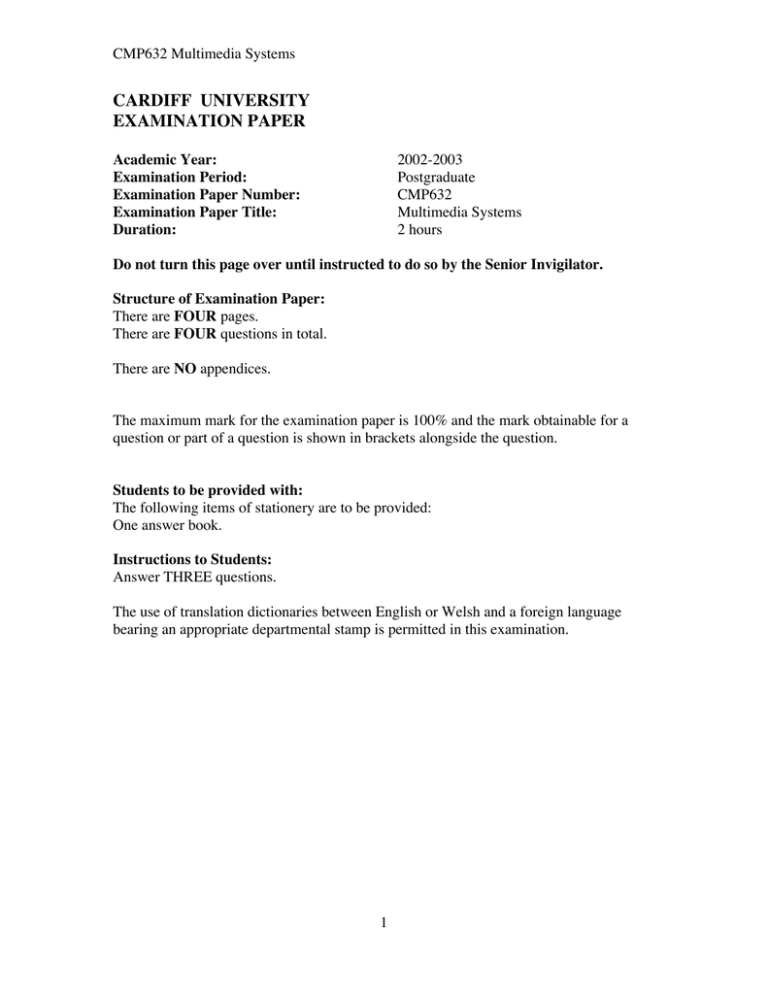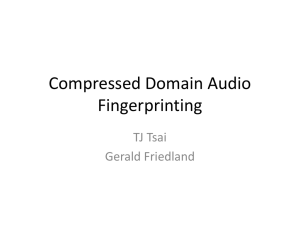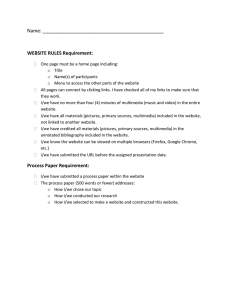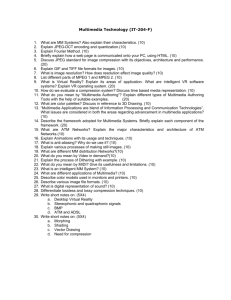CARDIFF UNIVERSITY EXAMINATION PAPER
advertisement

CMP632 Multimedia Systems CARDIFF UNIVERSITY EXAMINATION PAPER Academic Year: Examination Period: Examination Paper Number: Examination Paper Title: Duration: 2002-2003 Postgraduate CMP632 Multimedia Systems 2 hours Do not turn this page over until instructed to do so by the Senior Invigilator. Structure of Examination Paper: There are FOUR pages. There are FOUR questions in total. There are NO appendices. The maximum mark for the examination paper is 100% and the mark obtainable for a question or part of a question is shown in brackets alongside the question. Students to be provided with: The following items of stationery are to be provided: One answer book. Instructions to Students: Answer THREE questions. The use of translation dictionaries between English or Welsh and a foreign language bearing an appropriate departmental stamp is permitted in this examination. 1 CMP632 Multimedia Systems 1. (a) Give a definition of a Multimedia Authoring System. [2] (b) What key features should such a Multimedia Authoring System provide? [4] (c) What Multimedia Authoring Paradigms exist? Briefly describe 4 of these paradigms. [8] (d) You have been asked to create a multimedia presentation from a set of multimedia data that is distributed over the Internet. For example, a set of audio files exist at www.audio.com and a set of videos files reside at www.video.com. Essentially your task is to sequence a series of videos over a series of audio files where you may assume that the length of the audio and video sequences match. You may assume that the video files are video1.mpg, video2.mpg …. and that the corresponding audio files are audio1.wav, audio2.wav …. Which Multimedia Authoring paradigm is best suited to provide the best solution for this kind of task? Illustrate your answer with suitable fragments of example code. [10] 2 CMP632 Multimedia Systems 2. (a) What is MIDI? [2] (b) How is a basic MIDI message structured? [4] (c) A piece of music that lasts 3 minutes is to be transmitted over a network. The piece of music has 4 constituent instruments: Drums, Bass, Piano and Trumpet. The music has been recorded at CD quality (44.1 Khz, 16 bit, Stereo) and also as MIDI information, where on average the drums play 180 notes per minute, the Bass 140 notes per minute, the Piano 600 notes per minute and the trumpet 80 notes per minute. (i) Estimate the number of bytes required for the storage of a full performance at CD quality audio and the number of bytes for the Midi performance. You should assume that the general midi set of instruments is available for any performance of the recorded MIDI data. [7] (ii) Estimate the time it would take to transmit each performance over a network with 64 kbps. [2] (iii) Briefly comment on the merits and drawbacks of each method of transmission of the performance. [4] (d) Suppose vocals (where actual lyrics were to be sung) were required to be added to the each performance in (c) above. How might each performance be broadcast over a network? [5] 3. (a) What is meant by the terms frequency and temporal masking of two or more audio signals? Briefly, what is the cause of this masking? [7] (b) How does MPEG audio compression exploit such phenomena? Give a schematic diagram of the MPEG audio perceptual encoder. [8] (c) The critical bandwidth for average human hearing is a constant 100Hz for frequencies less than 500Hz and increases (approximately) linearly by 100 Hz for each additional 500Hz. (i) Given a frequency of 300 Hz, what is the next highest (integer) frequency signal that is distinguishable by the human ear assuming the latter signal is of a substantially lower amplitude? [4] (ii) Given a frequency of 5000 Hz, what is the next highest (integer) frequency signal that is distinguishable by the human ear assuming the latter signal is of a substantially lower amplitude? [5] 3 CMP632 Multimedia Systems 4. (a) What is the distinction between lossy and lossless data compression? [2] (b) Briefly describe the four basic types of data redundancy that data compression algorithms can apply to audio, image and video signals. [8] (c) Encode the following steam of characters using decimal arithmetic coding compression: MEDIA You may assume that characters occur with probabilities of M = 0.1, E = 0.3, D = 0.3, I = 0.2 and A = 0.1. (d) Show how your solution to (c) would be decoded. 4 [10] [4]



